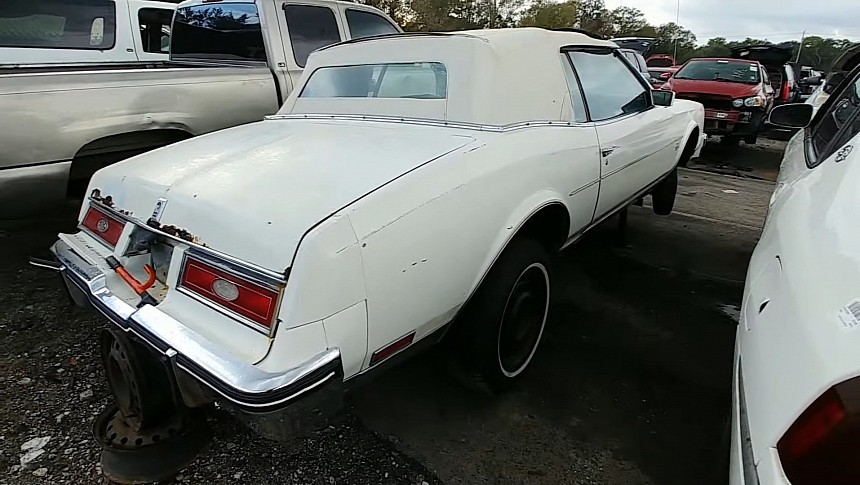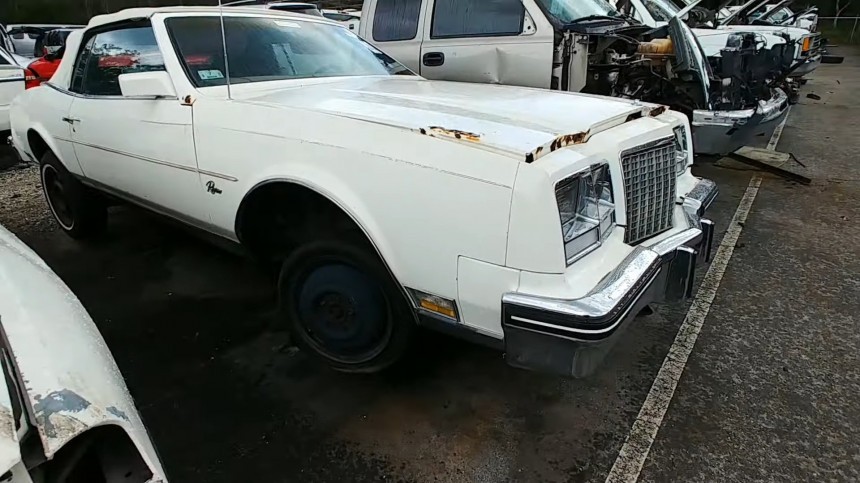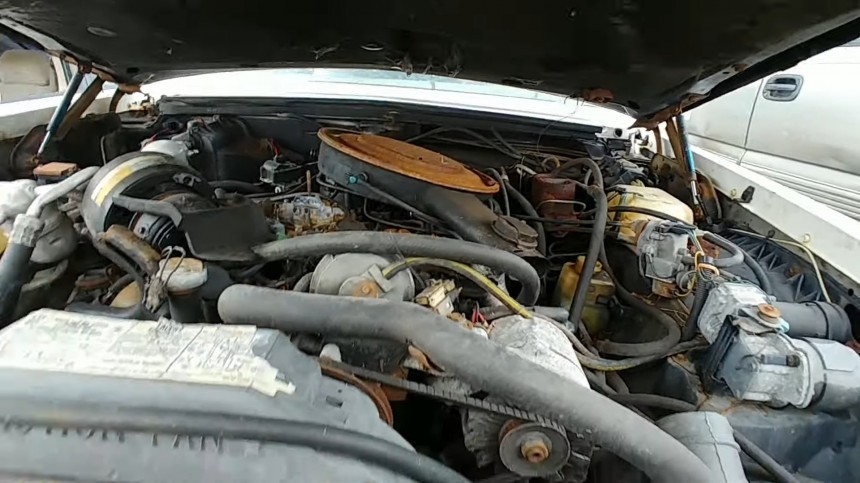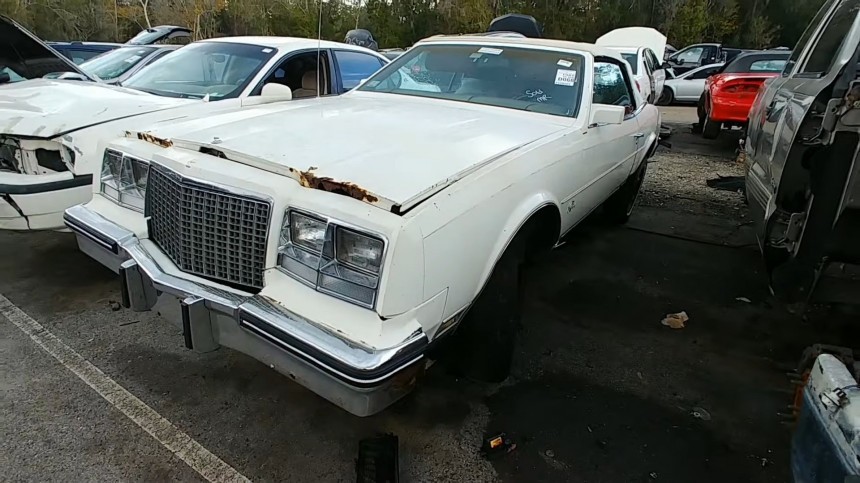The Malaise didn’t bring about just the castration of performance from every single automobile made in America. It also killed one iconic feature that had nothing to do – or it had everything to do, depending on the point of view – with the Clean Air Act, the oil embargo, or the rest of the Malaise bad memories: the convertible body style. Between 1977 and 1982, Detroit ceased to build soft-tops, but Buick put an end to the misery with the 1982 Riviera. Just 1,248 were assembled in the first year, so finding one 40+ years down the road isn’t something to look away from.
To be crystal clear – American carmakers didn’t produce convertibles off the assembly line. Still, coachbuilders had no restriction to take a coupe, chop the sheet of metal from above the cabin, and replace it with a piece of cloth. However, those cars weren’t ‘official’ drop-tops, as they hadn’t been designed, engineered, and assembled with the manufacturer’s ‘OK’ stamp. They were simply modified by a third-party shop, accordint to the owners' prefferences.
General Motors decided enough was enough in 1981 when they mandated the American Sunroof Corporation (ASC) to take Buick's coupes and make ragtops out of them. And what better nameplate to start a revolution than the Riviera? It all started at the 1981 Indy 500, paced by the Buick Regal T-top – that’s the project on which the GM Division and ASC first worked together (see photos of that pace car In the gallery).
In all likeliness, Buick nodded in approval about the ASC-T-top Regals, and the company entrusted the same partner with mass-assembling the convertible Riviera for 1982. The rationale behind this partnership was that General Motors wouldn’t block off a production line solely for the limited-numbers Riviera ragtops. Even more so, ASC had the logistical means and the engineering know-how to take care of the reconversion, so it was a win-win deal.
American Sunroof took the liberty of picking a 1981 Riviera coupe, making a soft-top, and going to Buick’s brass hats to show off. It paid off: Buick approved the idea and slated a 1,500-unit production for the 1982 model year. Eventually, the limited-edition Riviera Convertible fell just 252 units short of those estimates.
The new body style was introduced late in the model year – the first cars hit the showrooms in June, and they went out quickly despite their outrageous price tag of $24k. Save for the Cadillac limousines, it was the most expensive General Motors automobile for 1982. For comparison, a Cadillac Eldorado was priced some six grand under the open-top Buick.
It’s not that the Riviera differed vastly from the coupe it was based on (which cost just over $14,000). The 1982 Buick Riviera Convertible was part of a generation of E-bodied automobiles that debuted the front-wheel drive architecture for Buick, marking a historic premiere for the American make. In its initial year on the market, the obscenely expensive Riviera convertible (also a premiere for the model that only had solid roofs until then) used three different engines.
Owing to GM’s ‘corporate engine’ policy, Buick had to make do with Oldsmobile-built powerplants – two V8s offered for the Riviera were from its sister division. The 307-cubic-inch (5.0 liters) eight-cylinder was one of them, while the other was the infamous 350-cube Diesel (5.7 liters). In Buick’s defense, one motor was made in-house, the 252 cubic-inch V6 (4.1 liters). In January 1982, the T-Type Riviera was added to the list mid-model year, with the 238-cubic-inch (3.8-liter) Turbo V6.
All of them were mated to a four-speed automatic transmission with overdrive – it was the only gearbox available that year (and another first for Buick). Owing to the low production of the ‘verts, only two exterior colors were offered – white and metallic red – and a red or brown interior. The American Sunroof-installed soft top was also white or red.
Buick supplied the coupes straight out of the Linden, New Jersey facility and shipped them to Lansing for conversion. The cars were put together without the roof trims to keep everything straight until all modifications were finished. The first-year drop-top Rivieras had a flaw inherent in altering the structural design. Without a fixed roof, the cowl was prone to vibrations, and many examples had two bracing kits installed to keep the shake under control.
The vast majority of ‘vert Rivs got the 307-CID V8 – just like this one sitting in a junkyard in Florida, waiting for the crusher to end its miserable agony. Except for the rust – which isn’t all that bad but is noticeable on the body panels and undersides – it doesn’t look too far gone. The genuine leather on the front seats is torn badly, drastically contrasting the 35,000 miles (56,000 kilometers) on the odometer.
It could be that the distance-measuring clock has rolled over, but that’s an assumption. The lowly four-barrel Olds V8 upfront was not the greatest of engines – especially at high altitudes – with a measly 148 hp (150 PS) and 250 lb-ft (339 Nm). Owing to some delays in its availability, the Riviera didn’t break the bank in sales. By the end of 1985, it was retired, with less than 3,900 units made in the four years of production.
General Motors decided enough was enough in 1981 when they mandated the American Sunroof Corporation (ASC) to take Buick's coupes and make ragtops out of them. And what better nameplate to start a revolution than the Riviera? It all started at the 1981 Indy 500, paced by the Buick Regal T-top – that’s the project on which the GM Division and ASC first worked together (see photos of that pace car In the gallery).
In all likeliness, Buick nodded in approval about the ASC-T-top Regals, and the company entrusted the same partner with mass-assembling the convertible Riviera for 1982. The rationale behind this partnership was that General Motors wouldn’t block off a production line solely for the limited-numbers Riviera ragtops. Even more so, ASC had the logistical means and the engineering know-how to take care of the reconversion, so it was a win-win deal.
The new body style was introduced late in the model year – the first cars hit the showrooms in June, and they went out quickly despite their outrageous price tag of $24k. Save for the Cadillac limousines, it was the most expensive General Motors automobile for 1982. For comparison, a Cadillac Eldorado was priced some six grand under the open-top Buick.
It’s not that the Riviera differed vastly from the coupe it was based on (which cost just over $14,000). The 1982 Buick Riviera Convertible was part of a generation of E-bodied automobiles that debuted the front-wheel drive architecture for Buick, marking a historic premiere for the American make. In its initial year on the market, the obscenely expensive Riviera convertible (also a premiere for the model that only had solid roofs until then) used three different engines.
All of them were mated to a four-speed automatic transmission with overdrive – it was the only gearbox available that year (and another first for Buick). Owing to the low production of the ‘verts, only two exterior colors were offered – white and metallic red – and a red or brown interior. The American Sunroof-installed soft top was also white or red.
Buick supplied the coupes straight out of the Linden, New Jersey facility and shipped them to Lansing for conversion. The cars were put together without the roof trims to keep everything straight until all modifications were finished. The first-year drop-top Rivieras had a flaw inherent in altering the structural design. Without a fixed roof, the cowl was prone to vibrations, and many examples had two bracing kits installed to keep the shake under control.
It could be that the distance-measuring clock has rolled over, but that’s an assumption. The lowly four-barrel Olds V8 upfront was not the greatest of engines – especially at high altitudes – with a measly 148 hp (150 PS) and 250 lb-ft (339 Nm). Owing to some delays in its availability, the Riviera didn’t break the bank in sales. By the end of 1985, it was retired, with less than 3,900 units made in the four years of production.











































